A Simple Plan To Fix Patreon Without Swindling Supporters Or Creators

Those awful almost-changes they made? They could have avoided the whole problem by simply doing the math.
Designed for artists, writers, and creatives* of all different persuasions, Patreon has become a haven for content creators to connect with their supporters, and provided a hassle-free way for supporters to fund the creators and projects that matter to them most on an ongoing basis. Last week, Patreon made an announcement that they were changing their fee structure, leading with the announcement that creators were now going to take home 95% of the amounts pledged to them. Since creators typically received just 85–90% of their pledge amounts, this represented a big increase. But on closer inspection, it came at a tremendous cost: overcharging every one of their supporters. After a week of tremendous losses worldwide and very vocal outcries, Patreon backtracked and apologized, but the damage was colossal. Here’s a simple plan to fix everything.
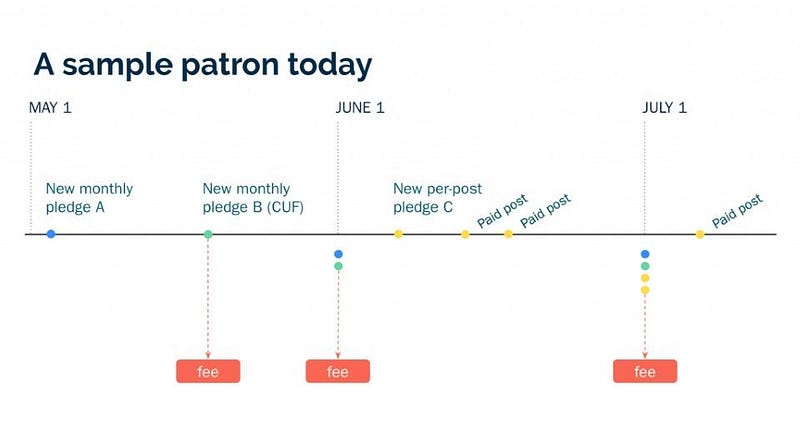
First, let’s start with the actual problem: Patreon’s existing fee structure. If you’re a creator, you presently have three options:
- Allow your patrons to donate monthly, at the start of the month.
- Allow your patrons to donate per piece that you create, billed all at once at the start of the month.
- Charge your patrons up-front, the moment they pledge, and then at the start of the month thereafter.
Patreon would charge every supporter the exact amount they pledged, adjusted for the number of pieces created (if applicable), and then bill everyone during the first few days of the month. On the 5th of the month, creators would get a lump-sum payout for all the pledges, minus the transaction fees (which range from 2–10%) and minus Patreon’s 5% cut.
The third option, mind you, is relatively new, and was added as a protection for creators. People were pledging not as a way to say, “thanks for what you’re doing,” but in an attempt to reap the rewards that creators dole out at various tiers to supporters. Particularly affecting creators with large amounts of Patreon-locked content, a fraction of patrons would pledge support, take the rewards, and then have their cards declined, effectively fleecing the creator. A charge-up-front option helped prevent that.
But that created a new problem: supporters were upset that they would pledge their support in the middle (or even at the end) of a month, get charged up front (for the whole prior month), and then get charged again in full when the first of the month rolled around. Effectively, they felt that they were getting double-charged. Meanwhile, a number of creators, as Patreon noted, were complaining about taking home only 85–90% of their pledge amounts.
So Patreon ushered in some very bad changes.
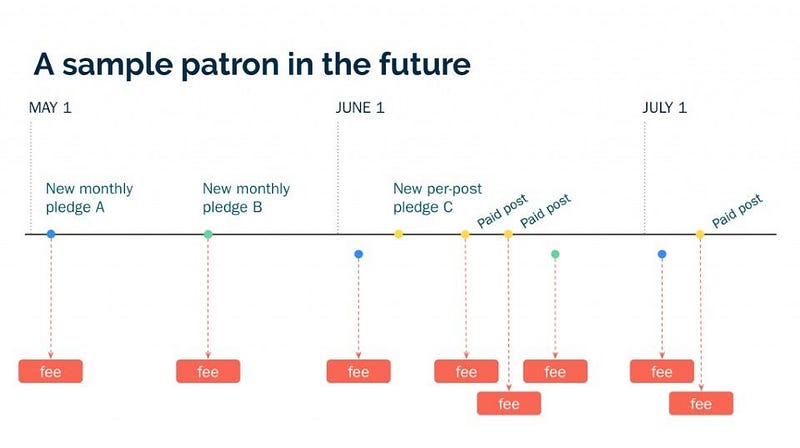
They decided:
- To charge all patrons on the monthly anniversary of when they first pledged, individually.
- To add on a transaction fee at the cost of the supporter, of 2.9% plus $0.35 per pledge.
- And then, after all that, to take out their 5% fee, leaving creators with 95% of what was pledged to them.
Patreon didn’t seem to understand exactly what it was doing, either, releasing the following image explaining the restructuring.
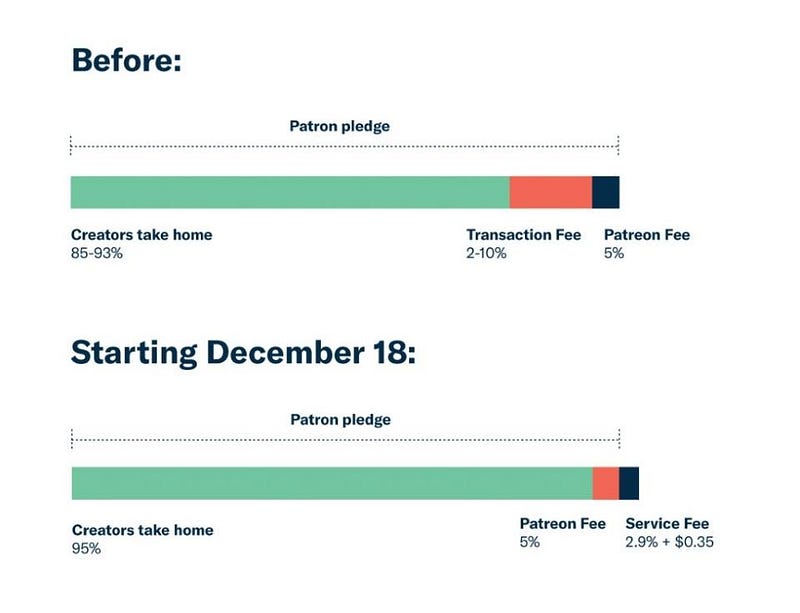
The transaction fee at the cost of the supporter, particularly since it was being charged per pledge, would actually mean a tremendous increase in fees. To break it down, it meant that, as a supporter, if you:
- Pledged $20/mo. to a single creator, you’d be charged $20.93/mo., or an extra 4.7% in fees.
- Pledged $10/mo. to a single creator, you’d be charged $10.64/mo., or an extra 6.4% in fees.
- Pledged $5/mo. to a single creator, you’d be charged $5.50/mo., or an extra 10% in fees.
- Pledged $3/mo. to a single creator, you’d be charged $3.44/mo., or an extra 15% in fees.
- Pledged $2/mo. to a single creator, you’d be charged $2.41/mo., or an extra 21% in fees.
- Pledged $1/mo. to a single creator, you’d be charged $1.38/mo., or an extra 38% in fees.
- Pledged $3/video to a creator that makes two videos a month, you’d be charged $6.87/mo., or an extra 14.5% in fees.
- Pledged $1/mo. to each of ten different creators, you’d be charged $13.80/mo., or an extra 38% in fees.
Here’s a breakdown of what the actual fee structure would have looked like under this system.
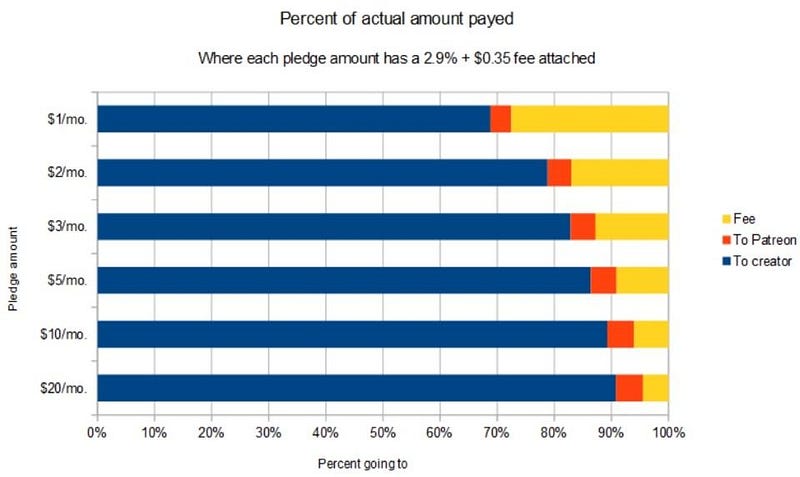
In other words, this made it more expensive to support multiple creators, to support creators who made more than one thing per month, or to support creators with a small donation. All of this is incredibly frustrating to both creators and supporters, since creators get the majority of their support from pledges at the $1–5/mo. level, and the majority of supporters donate at the $1–5/mo. level. The proposed new fee structure, dropped on creators and supporters without consultation, represented a serious breach of trust.
One problem could be that Patreon doesn’t realize what it actually is. Patreon is a place where patrons can support their favorite creators, and where creators can interact with and offer special treats to their patrons. It is run on generosity and good faith. The extra fees are a necessary evil; if Patreon can figure out a way to make its transaction fees or finances simpler and more efficient, it would be great to pass that extra money onto the creators, or to continue to develop new and better features that enable creators to interact with their supporters.

For financial transactions particularly involving interstate or international commerce, fees simply exist, and no transaction platform is without them. Flattr charges a total of 16.5%; Brave charges variable rates ranging from ~14% up to ~70%; Kickstarter (and other one-time platforms) has fees that range from 8–10%. For ongoing support, unless you’re content to build your own infrastructure for payments, rewards, and interactivity, Patreon as it is today is still the best deal out there for both supporters and creators.
Unfortunately, over the past week, creators across-the-board have seen a number of dissatisfied supporters simply leave, all due to Patreon’s rash and thoughtless actions.
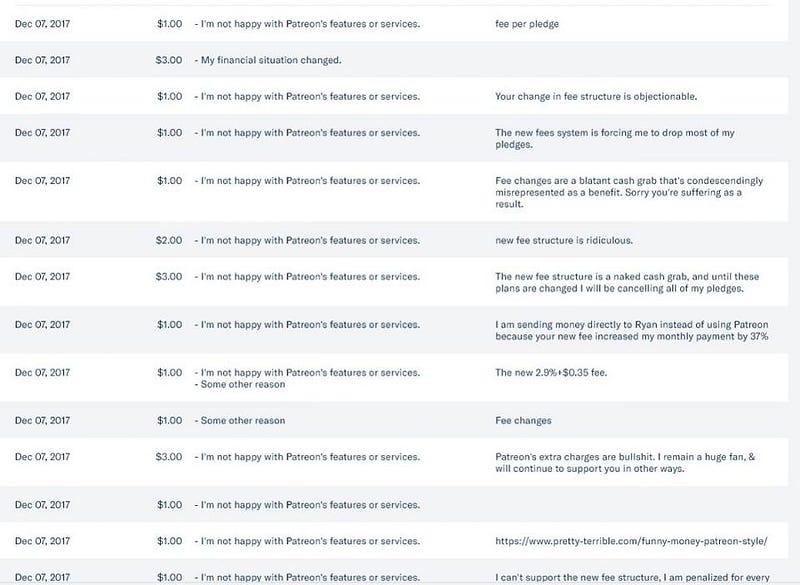
So how do you fix the problem? First, recognize that transaction fees are part of the business. Assuming that Patreon is minimizing them as much as possible and acting responsibly, and then using their 5% to pay their workers, develop their platform and infrastructure, and run their business, it’s a good business model and a good deal for everyone. In other words, that part of the business isn’t really all that. The only other issue is for those using the charge-up-front model. And to fix that, all you have to do is pro-rate the second charge to their account, the one normally charged at the top of the month, to get everyone on the same monthly schedule.
That’s it: problem solved. Every supporter can then support as many creators as they like at whatever level they like, pay just once a month, and Patreon can do once-a-month payouts, minimizing the fees for everyone. The less creators have to worry about their funding platform, the more they can focus on what everyone wants them to do: create. Attempting to force supporters to donate more than they’ve promised is not only unethical, it’s already come with a great cost: approximately 10–20% of patrons and pledges have left Patreon altogether over the past week. Patreon made the smart move to reverse course, but now it has a new responsibility: to rebuild the trust that both creators and supporters have lost for their company.
Ethan Siegel is both a supporter of others on Patreon, and a creator himself. You can find his Patreon campaign here.
Ethan Siegel is the author of Beyond the Galaxy and Treknology. You can pre-order his third book, currently in development: the Encyclopaedia Cosmologica.




